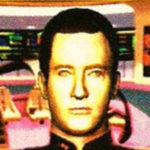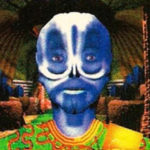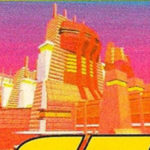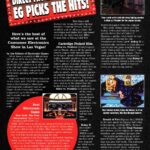1994 Spectrum HoloByte
Platform: 3DO and PC
Or as its full title: ‘Star Trek: The Next Generation – A World For All Seasons’. This early 3DO title was to be a ground-breaking interactive adventure game from Spectrum HoloByte, based on the famous franchise.

The game was a sort of “Choose-your-own-adventure” game, with many different options available that could lead you to other clues (or traps), with cinematic clips dropped in at various key points. A feature piece on the game in Electronic Gaming Monthly also indicates that there would have been real-time action sequences in space too.
@speedynoelle found a couple of pages on the game within an issue #0 of a Japanese 3DO magazine and shared them on Twitter/X, which included an article with Spectrum HoloByte about the game.
A rough translation suggests that there would be multiple endings depending on your choices within the game. Images would be rendered using 3D Studio on a PC, with animation scenes and lip-syncing of the characters done using a Silicon Graphics Indigo.
The story line and situations would be constructed by Spectrum HoloByte, following guidelines and technical specifications from Paramount. A very old post on the game from 1994 though suggests:
“The game’s plot is simple but with the added twist of random simulation: The Enterprise has been attacked and immobilized while orbiting an alien planet; the player assumes the identity of one of the Enterprise bridge crew and leads an “away” team Each character provides a different solution to the crisis based on the way he or she would approach the situation.
The presentation and actions are not all encoded. Even if you play the same character twice in a row, events will not necessarily unfold in exactly the same way.”
A feature in GameFan Volume 2 Issue 4 gives even more details:
“The Enterprise and its crew find themselves embroiled in a civil war that will determine the future of an entire planet. In this epic game, the player will have to work to unite warring factions and ultimately save an ancient, endangered race.
In addition to the interactive story telling nature of the game, there are going to be three different arcade sequences, including the all-out digitized, real time space battle shown here (see gallery). What will make this title unique is that the engine used to create the interactive environment in the game has been designed so that every game played becomes a new adventure.
This is accomplished in part, by allowing the player to switch between characters during the flow of the game. You can begin the game as Deanna, switch mid-game to Captain Picard and finish the game as Data, changing the nature of the experience as you change characters.”
It all sounded very impressed, and a preview video was also put on a Panasonic Sampler disk (which can be viewed here: https://www.youtube.com/watch?v=nVQhsgzAmkk ) to further excite users at the time. At some point we’ll try and add a video download of the preview to this page and to get some clearer screenshots.

An old web post at the time by Richard P Greenfield in 1994 revealed that designs for the game were being drawn up in Alameda, California at the design labs of Spectrum HoloByte, covering a whole manner of formats including the 3DO. There was even talk of a potential virtual reality development at the Paramount theme parks.
So why was the game cancelled? There were suggestions on an old Assemblergames.org post that the game was cancelled before it got very far at all – likely due to the failure of the 3DO as a whole. The programmer apparently sold some design documents some years ago, and confirmed that only a few CGI movies and basic interface work were ever done overall.
Thanks to Ross Sillifant, a Newsweek magazine ran an article on the 3DO which claimed that Spectrum Holobyte had stopped all 3DO development work at one point. The company issued a statement in response:
“We’re backing the 3DO platform because we believe that 3DO has superior interactive technology. Spectrum HoloByte is custom designing a title specifically for the 3DO system using the Star Trek(R): The Next Generation universe. This is one of our most ambitious titles to date,” said Gilman Louie, chairman, Spectrum HoloByte. “And, while Star Trek: The Next Generation is a custom-designed title for 3DO, we will also continue to include 3DO as part of our multiplatform port strategy.”Gilman Louie, CEO of Spectrum Holobyte, being quoted in a 3DO press release on Business Wire.
On an old 3DO message board from the time in 1994, a poster had told message viewers that he had just got back from CES. The Newsweek statement had been taken out of context, but apparently it was true. Although Spectrum Holobyte were showing the game at the CES event, the game was on hold according to contacts at the company.
If 3DO apparently had a good Christmas that year, then they would look to finish it. It was a huge game that required a lot of budget to complete, with the possibility that it could take up 3 CDs in total. Spectrum Holobyte needed to be confident that there was a decent market to sell the game to.
Oddly, the game was then reportedly shown at the CES 1995 event, where you could choose a scene in a little window in the upper left, but when you tried to go to that scene – the screen would black out and the same “scene selection” screen would come back up. Even Bill Watters from The 3DO Company was confident the game was still coming, saying that Spectrum HoloByte had told them that they were looking for a Summer release in 1995 (the original release date had been set for Summer 1994).
Another poster called “Bojay1997” claimed to have also spoke with the lead designer back in the day, where they said the demo shown on the 3DO demo disks was pretty much as far as the game got. Though there are suggestions that the demonstration at Spectrum Holobyte’s booth at the 1994 Summer CES had more advanced scenes which were not present on the disks. So, it still seems as if there was quite a bit done really.
Bojay1997 was reportedly told that the company apparently had financial problems and pulled programmers off the project to do other easier money making work.
Another suggestion from Neal (Senior Manager at 3DO Education and Customer Service at the time) was that Spectrum Holobyte had gone through several changes in development teams and never got far with the project before they ran into funding issues. From informal 3DO AOL conference logs from 1995, Neal tells all that the lead producer of the title had left, and afterwards Spectrum Holobyte found that the title was much further behind schedule than anticipated. As a result, they temporarily shelved the game.
Also – allegedly, Spectrum Holobyte had tried to originally hit up 3DO for a lot of money to develop the game, who said no. They then went to Panasonic and asked, who balked at the asking amount. The project apparently stagnated as a result with no funding. Finally, staff were reportedly placed onto other projects, with the producer then leaving. Not much was actually done or invested into the game.
So a whole thread of different suggestions and stories – but ultimately there needs to be a discussion with those involved directly to get to the bottom of what happened exactly and how far the game had actually got. Who worked on it then?
There is a suggestion that Andrew Probert was involved in the game in some way. However, the Japanese 3DO article lists someone called “Carrel” as a developer. This might be a bad translation – but hopefully someone can confirm. More research needed overall, and no doubt this page will evolve with new information as time goes on.
Also, there is a suggestion that a PC CD Rom version would be released as well in Electronic Games 1994-03. Was that true, or just a rumour?
Interestingly, Spectrum HoloByte did see the release of “A Final Unity” about a year later, which likely took on some of the early ideas of the 3DO game, possibly even assets. If you know anything more about this development or have any more resources that we can add – please let us know and this page will evolve over time.
Thanks to contributor SEM (see comments), the game was covered in a UK documentary on video games called Equinox: Serious Fun – which you can see here:
This reveals that Chris Hamilton was a 3D artist on the game, with Ron Martinez involved too as part of Creative Development at Spectrum Holobyte. Hopefully we can hear from both of them in the future to learn more about what happened.
With thanks to Karl Kuras for highlighting, Ross Sillifant for news archive information on the game, SEM for the video post, @speedynoelle for the article photos, and Archive.org for the scans.















































FYI the game was covered in a UK documentary on video games called Equinox: Serious Fun. The segment begins around the 32m mark.
That is superb, thank you SEM! Just added now with a credit to yourself!
Just sent a second stack of quotes etc from the time including 2 quotes from the 3DO company, as to why the game was canned.
Thanks Ross! Much appreciated and blended into the piece.
Sent over some ‘interesting’ back story and P. R statements from the time, along with speculation as to why the title was put on hold, then cancelled.
Hopefully they can prove to be of some use and provide some potential future contacts.
where is Seven of Nine :)